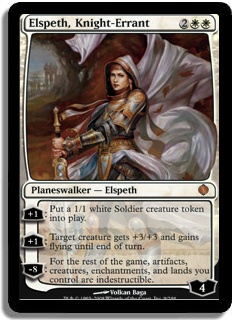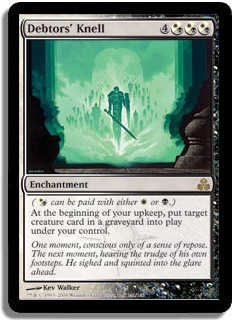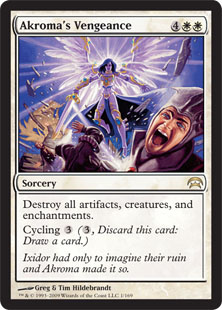Last week, I talked about
building forty-card decks out of the cube for each two-color pair
. The goal is to learn something about your cube in the process — which cards are pulling their weight, which archetypes or effects need more support, and how you can make the less viable strategies stronger. In the first article, I talked about what I had learned from just building the decks. In this one, I’m going to talk about my conclusions after testing.
What are the relative strengths of the decks?
In one sense, answering this question doesn’t tell you anything, because you could just swap cards around until the decks are evenly matched. For example, it was pretty obvious that my original U/W deck was overpowered compared to the rest — but I could have fixed that by moving Jace, the Mind Sculptor, Library of Alexandria, and Mana Drain around until that wasn’t the case. In most cases, I didn’t bother doing so, because my goal wasn’t to build cube duel decks (although
that’s a cool idea, too
).
What this question really came down to is: how easy is it to make this deck strong? It turned out that it was very easy for some combinations, and less so for others.

For example, the U/W deck was the best of the ones we built last week. It won against every other deck, and it’s not hard to see why. But if I wanted to make it stronger, I could — by running Path to Exile, Cryptic Command, or Time Walk. The deck would also benefit from another planeswalker in place of one of the finishers, so Elspeth, Knight-Errant or Venser, the Sojourner would benefit the deck.
On the other hand, it feels more difficult to improve some of the other decks. My R/W deck didn’t perform especially well. It felt pretty easy for the control decks to shut down a fast start with a few pieces of spot removal, and the games against the sweeper-heavy U/R deck were blowouts. Other times, I got my opponent down to one or two and couldn’t seal the deal.
It
felt
like the deck wanted more burn… but there’s a pretty delicate balance here, since the deck doesn’t function at all without a critical mass of aggressive creatures. Furthermore, there is only so much burn that interacts well with Armageddon. The deck really wants Lightning Bolts, but Char doesn’t fit as well in this deck. This deck was a great example of how cube
isn’t
like constructed — this deck really wants four-of burn spells and Figure of Destiny, and the lack of those hurts this archetype more than any other.
How could the weaker ones be improved?
Sticking with W/R as an example, let’s ask a question: how do you improve this deck, short of just throwing Highlanderness to the wind?
There are really two components to making a deck strong in the cube: the first is that it can just be powerful and have good matchups. In Limited, this usually feels to me like the deck has an easy time executing its game plan. For aggressive or mid-range decks, this means that you aren’t spending much time, if any, being reactive. For the control decks, it means that you stabilize at a reasonable life total while being ahead on cards, possibly through acceleration or mass removal.
The second is that the deck can be easy to draft. If a deck has a moderate power level compared to the others, but the cards that you need for it have some redundancy, than you can reasonably expect to build a good version of the deck when you draft it. Often, you’ll be more successful with a deck like that than one that has a higher potential power level, but needs the draft to go very well in order to achieve it.
The point of all that is
as I said here
, you can’t give every deck the same raw power level. What you can do, though, is to use redundant effects to give the weaker decks as much consistency as possible.

How hard is it to draft a deck like this? How could I make it easier, especially in the weaker combinations?
I talked a little bit about this last week, but it’s worth addressing the second part. The simple answer is to increase redundancy where possible. It became pretty clear during this exercise that every red deck wanted pretty much the same thing, and there wasn’t enough cheap burn to go around.
As much as I would like for red to have layers, all of the red decks would happily run the same spells if possible. The only real difference that shows up in my cube is the U/R can utilize board-sweepers to better effect. That’s not to say that red doesn’t have good cards that do something more interesting — it’s just that those cards have a less natural home.
Each red deck I built felt limited by having to share the burn spells (and to a lesser extent, land destruction) with the other decks. I’d now argue for including the strictly-worse burn spells, like Volcanic Hammer and Fire Ambush, to help those decks get the cards they want. I think this is especially important in Winston Draft, where you see only a fraction of the cards in the cube in each draft.
A similar thing happened in black, albeit to a lesser extent. While decks definitely want distinct things — Kokusho, the Evening Star vs. Vampire Lacerator — all those decks would have loved Thoughtseize. Hand disruption is important to the aggressive decks to stop the opponent from stabilizing. The control decks need hand disruption to deal with the non-creature permanents that dominate the game when they stick — things like planeswalkers and equipment.
After this exercise, I’m thinking of including Stupor and Inquisition of Kozilek to help these decks out. Inquisition especially should be at home in aggro decks like B/R, since you are most interested in hitting the early answers anyway.

What’s missing? Is there something that only one guild can do that might be worthy of more emphasis?
Earlier, I said that red does the same thing in every deck. To be fair, that doesn’t have to be true. If you include Wildfire and Burning of Xinye, you can build a pretty different red archetype. However, I don’t think anyone I play with is interested enough in drafting ramp to make that viable. But that’s certainly an archetype worth looking at if you’d be excited to draft it.
What is really missing in the decks I built is a representative non-blue control deck — usually W/R or W/B. I’ve had a lot of success with those decks, and there are great cards like Debtors’ Knell that really only fit there. These decks are admittedly weak against blue control, but they make up for that by being the best against creature decks, and less weak to non-creature permanents.
That said, I don’t think those decks need specific support, as all three of those colors naturally have the necessary removal and finishers. But it does mean that the impression of white as a predominately aggro color isn’t necessarily true- three of the white decks are about as comfortable in a control role.
What lacks focus? How can that be improved?
One thing I discovered while building is that most of the green land-fetch spells went unused. That’s partly an artifact of the format — there’s not much need for fixing in two-color decks with five dual lands that aren’t trying to splash anything. Still, it made me realize that we do play a lot of two-color decks, and green might be better served by other cards. I’m not sure what I’d be replacing them with, but I’m open to losing a Borderland Ranger or two at this point.
On the subject of green, I was really pleased by the performance of the G/W deck. It felt a little like playing standard Mythic — you just kept playing out threats until they ran out of removal, and then you won. I guess that means that what I’d really like for my cube is more Blastoderms…

What doesn’t fit in any deck? Are those cards worthwhile?
I wanted to look at a few notable cards that didn’t end up in any deck. Some of these are cube staples, and others aren’t — but they all deserve a look to see if they are earning their spot.
Hellkite Charger (along with Flameblast Dragon) have been great in my cube, but they aren’t exactly “on-plan” for any deck. Aggro decks want something cheaper, and control decks can usually find a more resilient finisher in another color. But using that logic to decide that the card isn’t worthwhile is completely flawed — because things don’t always go according to plan, in the draft or in the games. These guys are just fine (Flameblast Dragon is better than that, actually) in R/x control, and either is great in a deck that ended up more midrange than aggro. And if it’s the game that doesn’t go according to plan, they give you a way to not auto-concede after a slow start — kind of like the way some Onslaught goblins decks used a singleton Rorix Bladewing.
Four Wrath effects went unplayed — Rout, Akroma’s Vengeance, Martial Coup, and Austere Command. I think I could probably stand to lose one in an update, because while your white control decks always want a Wrath effect, I don’t often want more than two.
Speaking of Akroma, the lady herself also failed to find a deck. When I think about it, I don’t think Akroma, Angel of Wrath has been played in my cube in months. As amazing as she is, the high end in white is getting more and more crowed, and competition like Eternal Dragon is never dead and easier to reanimate as well.
Another big monster, Simic Sky Swallower, also got cut from my U/G deck. I don’t see that as a huge problem, though. While my deck was more interested in making lots of tokens and Opposition-locking, Simic Sky Swallower is an easy splash and sees a healthy amount of play. Even though he didn’t fit into my definitive U/G deck, I don’t see him getting replaced any time soon.
The issue here isn’t that any of the cards listed are bad — I’m just asking if they could be something more useful. If you are looking for a new perspective on what is and isn’t pulling its weight in your cube, I recommend trying this out. It’s given me a lot of ideas of what to do to improve my cube, and seeing what each guild wants has made it easy to see what can go.
A few things other things came up as we were playing the games (I played twenty-two out of the forty-five possible pairings):
Recursion is strong without disruption
I didn’t include any graveyard hate in these decks, and I really felt the difference. B/G and B/W felt pretty unassailable once they got going. After playing these games, I’m surprised that so few cubes run any dedicated hate cards.
Non-creatures matter
A huge number of games were won with planeswalkers, equipment (especially the Swords), and manlands. Part of that’s due to the fact that I didn’t include much maindeck artifact hate, but that isn’t too far off from usual game ones.
Manlands were also a big deal — I felt at a disadvantage whenever I was playing an enemy-guild deck against an allied one. Especially with the G/W deck, it felt great to have a Wrath-proof guy or two.
It’s the time of year for fresh starts, so it’s pretty sweet to have a lot of fodder for making cube changes as well. If you try this out, I’d love to hear how it works in your cube as well. Thanks for reading!
